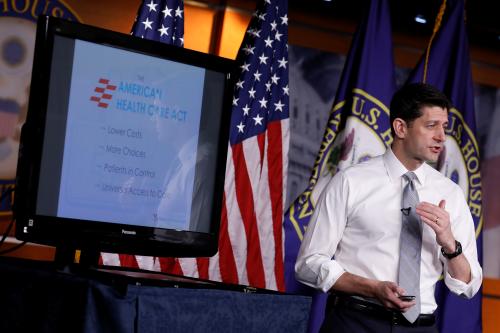This analysis is part of The Leonard D. Schaeffer Initiative for Innovation in Health Policy, which is a partnership between the Center for Health Policy at Brookings and the USC Schaeffer Center for Health Policy & Economics. The Initiative aims to inform the national health care debate with rigorous, evidence-based analysis leading to practical recommendations using the collaborative strengths of USC and Brookings. The article originally appeared in Health Affairs on April 19, 2017.
The answer to President Donald Trump’s recent musing that “Nobody knew health care could be so complicated” is that the staffs of the Congressional Budget Office (CBO) and of the Joint Committee on Taxation (JCT) clearly knew. The proof is the detailed, 37-page analysis the CBO issued on March 13, 2017, estimating the spending, tax, and coverage changes associated with the American Health Care Act (AHCA) — the House Republicans’ proposal to repeal and replace the Affordable Care Act (ACA). On March 23, the CBO updated its estimate of the AHCA (H.R. 1628) to incorporate “manager’s amendments 4, 5, 24, and 25.” Both proponents and opponents of the legislative proposal have focused intense attention on the CBO estimates.
As the administration and House Republicans mull ways to revive the AHCA, it is worthwhile to consider what the CBO report says about the bill, as well as what the reaction to the CBO’s AHCA estimates says about the way the agency’s role in congressional lawmaking has changed.
Basis for Changes estimated by the CBO
When “scoring” legislation, the CBO and the JCT start with in-depth analysis of how the legislative language would change current-law requirements, and then they program detailed computer models to translate those changes into the estimated increases or decreases in federal spending and tax revenues, along with other key variables of interest (such as changes in the number of insured and uninsured individuals). For more than a decade, the CBO and the JCT have invested heavily in understanding the complicated interplay between economic incentives and how individuals, insurance companies, employers, and state governments behave in response to government rules on insurance, Medicaid, taxes, tax credits, and other subsidies. The CBO and the JCT have converted their detailed understanding into mathematical models applied to large data sets — building what are known as “micro-simulation models.” The agencies have continued to refine and update their data, models, and understanding, incorporating new data on actual experience and feedback from independent experts.
CBO cost estimates follow clear rules and explicit conventions. The score of any legislative proposal reflects changes, measured against a current-law baseline, in spending (estimated by the CBO) and tax revenues (estimated by the JCT, with certain exceptions). Other than incorporating the effects of newly enacted legislation, the CBO generally does not change the baseline during a congressional session; this facilitates fairly assessing the scores assigned to alternative proposals and avoids “moving the goal posts” during the course of a year. In addition, the CBO must analyze the legislative language in a bill and may not consider unspecified changes, such as provisions envisioned for a companion bill or potential regulatory changes.
At the request of the congressional budget committees, the CBO and the JCT estimated the effects of the AHCA compared to the fiscal year (FY) 2016 — 2026 baseline, using the baseline issued in 2016 (March 13 Estimate at 1). One consequence of the direction to use last year’s baseline was to preclude updating last year’s estimates of insured individuals, which would have automatically occurred were the CBO asked to score the AHCA using the 2017 baseline. This year’s baseline reflects the CBO’s most recent estimates of spending and revenues for the 10-year “budget window” of FY2018 — 2027, plus the current fiscal year, FY2017 (which started on October 1, 2016, and ends on September 30, 2017).
The enormous complexity of health care, the stark variations across the country, and the significant changes proposed in the AHCA require a carefully constructed, detailed model to estimate the key elements of change and how the changes interact.
The enormous complexity of health care, the stark variations across the country, and the significant changes proposed in the AHCA require a carefully constructed, detailed model to estimate the key elements of change and how the changes interact. The CBO and the JCT have devoted enormous effort to understanding and incorporating in their modeling the complex interplay of forces in the health care system, the relationships among the key variables, and the impact of policy changes. The CBO estimates conform to the rules governing congressional scorekeeping, are highly credible, and benefit from extensive review and comments on prior analyses. In addition, the CBO has explained its modeling in multiple reports and presentations.
The CBO and the JCT estimate that H.R.1628, as amended, would reduce the number of insured people by 14 million in 2018 (24 million in 2026) and federal deficits by $150 billion (2017 — 2026), reflecting $1.15 trillion in lower federal spending and $1.0 trillion in lower tax revenues. The March 13 report also carefully explains the factors analyzed by the CBO and the JCT, and how the legislative provisions change the 2016 baseline. The March 24 report concludes that the manager’s amendments do not materially change the March 13 estimates of individuals losing insurance or health insurance premiums.
Acknowledging significant uncertainty in the estimates but wanting to “develop estimates that are in the middle of the distribution of potential outcomes”, the CBO articulates what appears to be an unassailable overall conclusion:
“[S]pending on Medicaid would almost surely be lower than under current law. The cost of the new tax credit would probably be lower than the cost of the subsidies for coverage through marketplaces under current law. And the number of uninsured people under the legislation would almost surely be greater than under current law” (March 13 Estimate at 26).
Criticisms of the CBO estimates based on not reducing the number of insured individuals assumed in its 2016 baseline or only reflecting one “prong” of a three-prong strategy (where the other two prongs involve unspecified regulatory and legislative changes) are not valid criticisms of a congressional cost estimate that follows the budgetary conventions under which the CBO has operated for decades. Rather, such criticisms reflect the desires of advocates who want the CBO to provide something different than a cost estimate.
Key Takeaways from CBO Estimates
Stable Non-Group Insurance Market
Over and above tax credits (subsidies) for participants in the non-group market with incomes below 400 percent of the federal poverty level (FPL) (which equals $12,060 for an individual in 2017 except in Alaska and Hawaii) and penalties for not having insurance (the individual mandate), current law reflects four additional ACA-created provisions to stabilize the non-group insurance market. The provisions included cost-sharing reductions (for those with incomes up to 250 percent of FPL), risk adjustment, reinsurance, and risk corridors. Many of these provisions were constrained by opponents of the ACA, as reflected in efforts to limit cost-sharing reduction and risk corridor funding.
The AHCA provides for cost-sharing reductions (through 2019), risk adjustment, and reinsurance (through 2026). In fact, with the $100 billion Patient and State Stability Fund (2018 — 2026), the AHCA substantially increases funding available for reinsurance. Taking these market-stabilization provisions (along with other provisions) into account, the CBO concludes that “the non-group market would probably be stable in most areas under either current law or the legislation.” Increasing funds available for tax credits (as discussed below) reinforces this assessment from the March 13 report. Adding $15 billion more, as proposed in an April 6 amendment (by Representatives Gary Palmer [R-AL] and David Schweikert [R-AZ]), would further stabilize the market by authorizing an “invisible risk sharing program” patterned after programs implemented by Maine and Alaska.
AHCA Shifts But Does Not Lower Health Care Costs
The CBO analysis makes clear that the AHCA would reduce the share of health care costs paid by the federal government, but the analysis does not indicate that the AHCA would significantly reduce either what health care costs or how quickly costs grow. In the non-group market, the AHCA lowers the amount of tax credits and subsidies, constrains their rate of growth, and permits lowering the share of health care costs (the actuarial value) covered by insurance. The Medicaid provisions lower federal funding that match state spending, constrain the rate of growth in per capita amounts (caps), and limit eligibility. The CBO projects that health care costs will increase faster than the tax credit inflation factor (consumer price index or CPI), Medicaid costs will increase faster than the per capita cap limit (medical portion of the CPI or MCPI, except MCPI plus 1 percent for the elderly and disabled), and the average actuarial value of non-group policies will decline below current law levels.
The changes described above, along with eliminating the ACA’s cost-sharing reductions, lowering tax credit amounts, and other Medicaid changes, shift more costs (and risk) onto beneficiaries—who would incur higher out-of-pocket expenses (including insurance deductibles)—and states (which may choose to increase their costs, limit eligibility, cover fewer services, or reduce payments to providers).
AHCA Converts “Defined Benefits” Into “Defined Contribution
Under current law, the cost of non-group insurance in the area (that is, the second-lowest-cost silver plan premium in a market) determines the level of the premium subsidy received by about 85 percent of ACA Marketplace enrollees. Subsidies under current law are thus linked to the regional cost of health insurance—and reflect differences across regions—whereas under the AHCA, the average subsidy is nationally uniform and limited by the slower-growing CPI. As a result, the AHCA converts tax credits (subsidies) to a defined contribution: The “base” amount (specified in the proposals) is updated by general inflation, regardless of the cost of insurance. The CBO estimates that the average subsidy under the AHCA would equal 60 percent of the current law subsidy amount in 2020, declining to 50 percent of the current law in 2026.
The manager’s amendments would facilitate having the Senate allocate additional funds (reports suggested $85 billion over 10 years) to increase tax credits for older individuals in the non-group market. As noted above, the amendments would also increase the inflation index limiting “per capita caps” for elderly and disabled Medicaid recipients. The manager’s amendments do not fundamentally alter the shift from defined benefit to defined contribution.
AHCA Lowers Federal Spending By Reducing The Number of Insured Individuals, Which Lowers Tax Credit And Federal Medicaid Costs
Current-law subsidies for the non-group market are linked to local market costs and the incomes of people between 100 percent and 400 percent of FPL. The AHCA essentially doubles the income limit at which non-group enrollees receive subsidies. For individuals, ACA subsidies are largest for those with incomes of $12,060 and are phased out at $48,240 in 2017. In contrast, full AHCA subsidies are provided to non-group enrollees with incomes up to $75,000, above which they phase out. Although more people would be income eligible for the tax credit, the CBO estimates that the average value of the credit would be substantially reduced.
The March 24 CBO report estimates that federal Medicaid payments would be reduced by $839 billion (2017 — 2026). The legislation further restricts eligibility and funding for the Medicaid “expansion” population and creates options for imposing work requirements and converting per capita caps to block grants, among other changes.
Eliminating ACA Taxes On Upper-Income Individuals, Health Plans, Drug Companies, Device Manufacturers, And Other Provisions Offsets 87 Percent Of Reduced Federal Spending
Two of the tax provisions repealed by the AHCA (at a cost of $275 billion, 2017 — 2026) apply only to high-income individuals. Taxes imposed by the ACA on health insurers, drug companies, and medical device manufacturers would also be eliminated. The manager’s amendments advance the effective dates of the provisions eliminating taxes and delay the start of the so-called “Cadillac tax” to 2026, which further reduces tax revenues. In total, the AHCA lowers federal revenues by $1.0 trillion compared to $1.15 trillion in lower federal spending, leading to a net deficit reduction of $0.15 trillion.
AHCA Significantly Redistributes Federal Spending And Subsidies Across Income Groups, Age Groups, And Geographic Areas
The AHCA markedly reduces funding for the 31 Medicaid expansion states plus the District of Columbia, imposes a nationally uniform growth cap on allowable per capita Medicaid costs that would cause states with faster than average growth to incur added costs, but increases funding ($39 billion, 2017 — 2026) for the non-expansion states.
Unlike current-law subsidies that are pegged to local market costs and phase out as income rises, the AHCA lowers the average value of tax credits, essentially doubles the income limit for tax credit eligibility, creates a nationally uniform schedule of tax credits, ties tax credit amounts to age, and eliminates cost-sharing reduction subsidies. As a result, the AHCA not only reduces the average value of subsidies for non-group insured enrollees but redistributes funds away from lower-income participants, areas with high health care costs, and older individuals.
Comparing Current Controversy About CBO Estimates To Earlier Health Reform Debates
CBO cost estimates played a pivotal role in earlier health reform initiatives. For example, more than 20 years ago, the CBO estimated the effects of “managed competition” reform proposals advanced by President Bill Clinton, including determining which arrangements would rely on sovereign authority and be scored as “on budget.” This led observers to characterize the CBO director as the “man who delivered the bad news — to [congressional] committees, to rump groups, to ad hoc gatherings that wrestled one after another with the same insoluble issues.” The CBO played similarly pivotal roles during the years of congressional deliberations that led to enactment of the Medicare drug benefit in 2003 and the ACA in 2010. In both the current and past debates, the CBO’s scoring reflected the CBO’s assessment of critical elements of reforms; examples include determining the cost of competitive versus governmental plans (such as the “cost management factor” for drug plans), the viability of a public option, the cost of Medicaid versus non-group coverage, and the response of individuals to new insurance offerings.
In the earlier debates, proponents with strongly held views frequently, and forcefully, expressed disagreement with the CBO’s assessments and estimates. Only rarely, however, was the legitimacy of the institution challenged. Despite strong disagreements, both proponents and opponents in past debates generally recognized the need to have a non-partisan, impartial scorekeeper, and accepted the CBO in that role. Congressional leaders, committee staff, and administration officials worked to shape their proposals to improve their CBO score.
Today, we live in very different environment. Given the magnitude of our fiscal challenges—the growing and ongoing imbalance between revenues and spending, resulting in massive increases in debt held by the public—the importance of having non-partisan, expert, analytic institutions will only grow. We undermine the CBO and the JCT at our peril.









Commentary
Looking backward and forward: Assessing the CBO/JCT analysis of the AHCA
April 19, 2017